China Reorganizes Northern Nuclear Missile Launch Sites
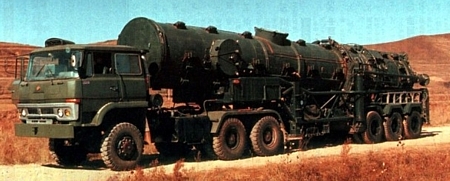 |
|
A dozen trucks identified at possible missile launch sites near Delingha in the northern parts of central China resemble the DF-21 medium-range ballistic missile launcher. If correct, about a third of China’s DF-21 inventory is deployed within striking distance of Russian ICBM fields. |
By Hans M. Kristensen
China has significantly reorganized facilities believed to be launch sites for nuclear ballistic missiles near Delingha in the northern parts of Central China, according to commercial satellite images analyzed by the Federation of American Scientists.
The images indicate that older liquid-fueled missiles previously thought to have been deployed in the area may have been replaced with newer solid-fueled missiles. From the sites, the missiles are within range of three Intercontinental Ballistic Missile (ICBM) fields and a bomber base in the southern parts of central Russia.
Analysis of Changes
The Chinese launch sites, which are located at an elevation of approximately 10,000 feet (3,000 meters), are in an area that for years has been rumored to be a deployment area for liquid-fueled DF-4 long-range nuclear ballistic missiles. In November 2006, FAS and NRDC published Chinese Nuclear Forces and U.S. Nuclear War Planning, which used satellite images to describe the two launch sites. Several other apparent sites nearby did not have any infrastructure and many appeared abandoned.
|
|
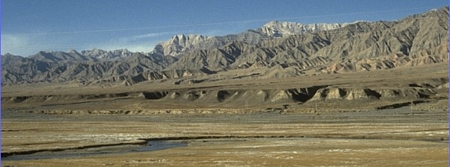 |
|
The launch sites are located at approximately 10,000 feet (3,000 meters) on the slopes of this mountain range north of Delingha. This image (used with permission) was shot approximately six miles (10 kilometers) from Delingha. |
The southern launch site has changed most dramatically. In late-2005, the site had what appeared to be a large missile garage, approximately 40 small buildings (possibly crew quarters), and more than half a dozen service trucks. A gate was also visible. In the new image from late-2006, all of those features are gone with only a single service truck visible on the launch pad, and the access road appears to have been paved (see below).
|
|
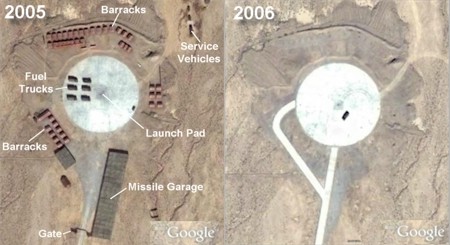 |
|
The southern launch site at Delingha (37°24’27.47″N, 97° 3’21.18″E) changed dramatically between late-2005 (left) and late-2006. All buildings were been removed and only a few small trucks remain. The 250-feet (80-meters) launch pad and the access roads have been paved. |
The second launch site some 2.5 miles (4.3 km) to the north has also changed significantly, but here operations appear to have increased. In late-2005, this site included what appeared to be a missile garage, an underground facility, approximately 15 buildings, and less than a dozen service trucks of various sizes. The new satellite image from late-2006, however, shows that the large garage has been removed, the number of buildings nearly doubled, the access roads paved, and work appears to be in progress next to the underground facility (see below).
|
|
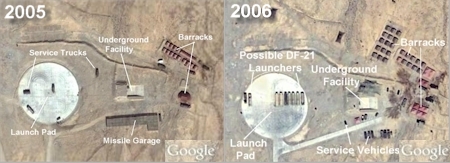 |
|
The northern primary launch site has been expanded significantly between late-2005 (left) and late-2006. Numerous new buildings have been erected, the access roads have been paved, work appears to be in progress next to the underground facility, and six 13-meter trucks that resemble launchers for the DF-21 MRBM are clearly visible on the launch pad. Check it out on Google Earth. |
Most interestingly, clearly visible are eight 13-meter trucks lined up on the launch pad. The satellite image is not of high enough resolution to identify the trucks and their features with certainty, but they strongly resemble the six-axle transport erector launchers (TELs) in use with the 10-meter DF-21 medium-range ballistic missile. A vague line across the trailer two-thirds toward the rear resembles the position of the hydraulic pumps used to erect the missile canister to a vertical position.
|
|
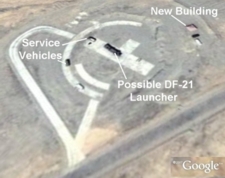 |
|
Possible DF-21 launchers are also visible at several of a dozen smaller possible launch sites. This one, north of the main site (Site 2), has also been upgraded with a new building. |
Changes to Other Delingha Sites
The two launch sites described above are the most actively visible in the satellite images. But there are more sites that appear to be involved in missile operations. North along the main road is what appears to be five smaller dispersed parking or launch platforms. None of these sites had any vehicles or infrastructure visible in 2005, but the new image shows one 13-meter truck present at four of the five sites. One of the sites appears to be upgrading with new access roads, a building, and half a dozen service vehicles (see right).
Further to the west, approximately 10 miles (17 km) from site 1 and 2, is another road leading north into the mountains. Along this road, another eight possible dispersal launch sites are visible. No 13-meter trucks, buildings, or other vehicles are visible at these sites.
The DF-21 Medium-Range Ballistic Missile
The DF-21 is a medium-range ballistic missile estimated by the U.S. Defense Intelligence Agency (DIA) to have a range of approximately 1,330 miles (2,150 kilometers). It is China’s first solid-fueled ballistic missile and believed to carry a single warhead with a yield of 200-300 kilotons. Full operational deployment began in 1991. The missile is approximately 33 feet (10 meters) long and launched from a six-axle transporter erect launcher (TEL). Two versions of the missile are deployed, according to the DOD. Some might have been converted to carry conventional warhead.
|
|
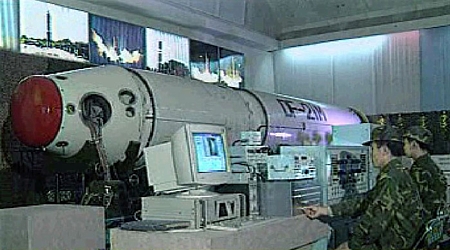 |
|
A DF-21 medium-range ballistic missile during calibration. |
The Defense Intelligence Agency estimated in 1996 that the DF-21 was expected to complement and possibly take over the strategic targeting role of the DF-3 by 2000. But introduction was slow. Whether this is now happening, and whether the DF-21 is also replacing DF-4s in some roles is unknown. The DOD’s annual report on China’s military power for years showed great uncertainty about the number of DF-21s, the 2006 report listing a range of 19-50 missiles on 34-38 launchers. The 2007 report, however, lists 40-50 missiles on 34-38 launchers, which suggests the DOD believes the number of missiles has increased while the number of launchers has stayed the same.
|
|
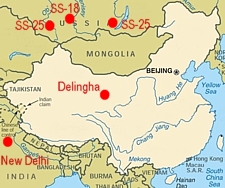 |
|
From Delingha the DF-21 is in range of northern India (including New Delhi) and three Russian ICBM fields and a bomber base. |
Uncertainties and Implications
It is important to caution that there is no information publicly available that confirms that the Delingha sites are launch sites for ballistic missiles, or that the 13-meter trucks indeed are DF-21 launchers. First, the changes at the sites may be routine because nearly all of China’s ballistic missile are mobile, and the support units are designed to follow the launchers wherever they go. Second, the rumored DF-4 deployment in the area may have been wrong, or the DF-21 may have moved in years ago but only been publicly visible now. U.S. and Russian spy satellites probably have monitored the changes at Delingha on a daily basis and provided a much more detailed understanding of what is happening at the sites.
Yet the indications that the DF-21 is deployed at Delingha appear to be strong. And if the dozen 13-meter trucks visible on the satellite images at Delingha indeed are DF-21 TELs, then 32-35 percent of China’s estimated inventory of DF-21 launchers are deployed in central China.
With a DIA-listed range of 1,330 miles (2,150 kilometers) the DF-21s would not be able to reach any U.S. bases from Delingha, but they would be able to hold at risk all of northern India including New Delhi. Moreover, and this is perhaps the most interesting implication of the discovery, DF-21s would be within range of three main Russian ICBM fields on the other side of Mongolia: the SS-25 fields near Novosibirsk and Irkutsk, the SS-18 field near Uzhur, and a Backfire bomber base at Belaya.
Whereas targeting New Delhi could be considered normal for a non-alert retaliatory posture like China’s, targeting Russian ICBM fields and air bases would be a step further in the direction of a counterforce posture. But again, it is unknown exactly what role the Delingha missiles have, and the DF-21 may not be accurate enough to pose a serious risk to hardened Russian ICBM silos. Regardless of targeting, Delingha appears to be very active.
|
|
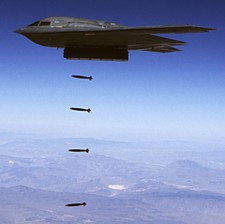 |
|
A single B-2 stealth bomber with conventional JDAM bombs would probably be sufficient to incapacitate the Delingha missile launch sites. |
One of the most striking features about the sites is their high vulnerability to attack. All appear to be almost entirely surface-based facilities (although Site 2 has an underground structure), and a mobile missile launcher is extremely vulnerable once it has been discovered. The sites were possible DF-21 launchers were detected are located within a distance of about six miles (10 kilometers). A single high-yield nuclear warhead would probably be sufficient to neutralize the entire force visible in the images.
But an adversary might not even have to cross the nuclear threshold. A single U.S. B-2 bomber loaded with non-nuclear JDAM bombs (see this video) would probably be sufficient to neutralize the dozen launch sites seen in the images. The United States has begun to incorporate such advanced conventional weapons into its strategic strike plans to give the president “more options.” Since China has repeatedly pledged that it “will not be the first to use such [nuclear] weapons at any time and in any circumstance,” some might conclude that a conventional strike on Chinese nuclear forces would not trigger Chinese use of nuclear weapons. But whether Beijing (or anyone else) would indeed stand idle by as its nuclear forces were taken out by conventional weapons is highly questionable.
Background: Chinese Nuclear Forces and U.S. Nuclear War Planning | Delingha on Google Earth
The FY2026 National Defense Authorization Act (NDAA) paints a picture of a Congress that is working to both protect and accelerate nuclear modernization programs while simultaneously lacking trust in the Pentagon and the Department of Energy to execute them.
While advanced Chinese language proficiency and cultural familiarity remain irreplaceable skills, they are neither necessary nor sufficient for successful open-source analysis on China’s nuclear forces.
Satellite imagery has long served as a tool for observing on-the-ground activity worldwide, and offers especially valuable insights into the operation, development, and physical features related to nuclear technology.
This report outlines a framework relying on “Cooperative Technical Means” for effective arms control verification based on remote sensing, avoiding on-site inspections but maintaining a level of transparency that allows for immediate detection of changes in nuclear posture or a significant build-up above agreed limits.